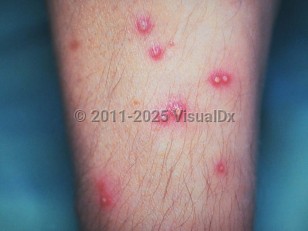Listeriosis
Alerts and Notices
Important News & Links
Synopsis

Although most adult infections appear to be minimally symptomatic, clinical presentations can range from mild to severe illness. Most symptomatic adult infections occur in immunocompromised patients and in those at the extremes of age, but infection in immunocompetent hosts does occur, particularly in farmers and veterinarians. Listeriosis is associated with increased susceptibility among pregnant individuals, who account for 1 in 4 reported cases in the United States. Infections during pregnancy can lead to stillbirth.
Severe infections present with meningitis, gastrointestinal symptoms and signs, or a glandular fever-like illness. Hematogenous spread and widespread dissemination is uncommon.
Cutaneous involvement outside of the neonatal period is rare and usually occurs from direct inoculation of the skin in farmers or veterinarians who are exposed to animal products of conception.
Pediatric patient considerations: As with adults, in children, infection and illness are more likely in the immunocompromised. Infection can occur by ingestion of contaminated or unpasteurized milk or ingestion of cheeses from unpasteurized milk.
The highest incidence of disease is in the neonatal period. See neonatal listeriosis for more information.
Codes
A32.9 – Listeriosis, unspecified
SNOMEDCT:
4241002 – Listeriosis
Look For
Subscription Required
Diagnostic Pearls
Subscription Required
Differential Diagnosis & Pitfalls

Subscription Required
Best Tests
Subscription Required
Management Pearls
Subscription Required
Therapy
Subscription Required
Drug Reaction Data
Subscription Required
References
Subscription Required
Last Updated:04/24/2024
 Patient Information for Listeriosis
Patient Information for Listeriosis - Improve treatment compliance
- Reduce after-hours questions
- Increase patient engagement and satisfaction
- Written in clear, easy-to-understand language. No confusing jargon.
- Available in English and Spanish
- Print out or email directly to your patient


